11th Evacuation Hospital Unit History

Handbook and introduction guide to Camp Joseph T. Robinson, Little Rock, Arkansas. Initially a Branch Immaterial Replacement Training Center (BIRTC), later converted into an Infantry Replacement Training Center (IRTC).
Introduction & Activation:
The 11th Evacuation Hospital, a non-affiliated mobile medical unit, was activated February 10, 1941 at Camp Joseph T. Robinson, Little Rock, Arkansas (Infantry Replacement Training Center, acreage: 42,124, troop capacity: 2,596 Officers & 44,077 Enlisted Men –ed) following orders emanating from the Surgeon, Second United States Army. A Branch Immaterial Replacement Training Center was established at Camp J. T. Robinson January 14, 1942 and organized into five Training Regiments; the 11th – 12th – 13th – 14th and 15th. A Medical Replacement Training Center was activated January 15, 1942; it consisted of three Medical Training Regiments; the 21st – 22d – and 23d. Like the BIRTC it started with an eight-week training cycle (under a new MTP 20-2 program), which later doubled. Official classes started February 1, 1942 and ended October 11, 1943, after which the medical center closed October 14. In January 1943, the BIRTC was converted into an Infantry Replacement Training Center which started with an original training cycle of eight weeks, later to expand to sixteen weeks, and eventually shortened to meet immediate manpower requirements, as fillers for units to be activated and for overseas garrisons and bases were needed at once and in greater numbers than could be supplied by the existing RTCs. In 1944, the IRTC expanded and all remaining medical units were turned into Infantry training organizations. Camp Joseph T. Robinson was now authorized a capacity of 878 Officers and 4,024 EM, with a total training accommodation for 21,000 men.
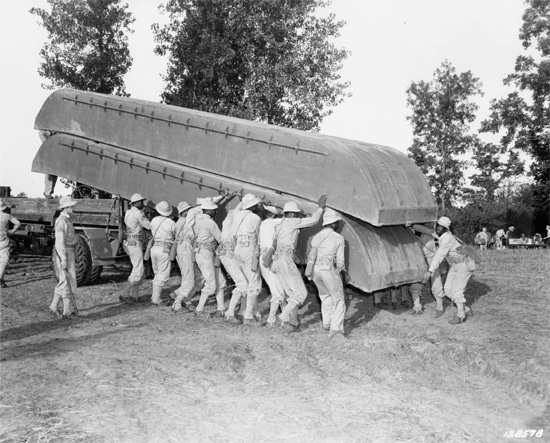
Photo taken during the Second United States Army Maneuvers in Arkansas, August 1941.
As per the Staff Officers’ Field Manual FM 101-10, “Organization, Technical, and Logistical Data”, dated June 15, 1941 an Evacuation Hospital received all classes of patients and prepared them for evacuation by rail. Its bed capacity was 750, but could be increased to 1,200, for a period not to exceed 3 days. It was recommended to set up this type of hospital 12 to 30 miles from the front, and preferably on a road or on a railroad leading to the rear. The minimum space requirements were 200 x 200 yards under tentage. Establishment required 4 to 6 hours and 8 to 10 for dismantling (when empty). Movement by rail required 2/3 of a train, or 184 truck tons by road (for equipment only). T/O 8-232 authorized 47 Officers – 52 Nurses – and 318 Enlisted Men (same numbers were later taken over in T/O 8-580, dated July 2, 1942, including 8 vehicles and 2 trailers –ed).
After participating in the various training programsand gradually being brought up to its authorized strength, the organization was converted from a 750-bed capacity hospital to a 400-bed Evacuation Hospital prior to being sent overseas.It served in French Morocco and Tunisia, and eventually moved to Sicily and Italy, before being transferred to Southern and Eastern France, from where it later entered Germany.
Training:
Initially activated as a basic training unit at Camp Joseph T. Robinson, the 11th Evac only held few Officers, including John H. Taber (Commanding Officer), Keith E. Wilcox (Mess Officer), Paul S. Anderson (Supply Officer), and James W. Lannon (Fire Marshall & Transportation Officer). A cadre of 8 Enlisted Men from the Army and Navy General Hospital, Hot Springs, Arkansas, and 142 Selective Service draftees from the Reception Center at Fort Leavenworth, Kansas, joined the unit.
An intensive 13 weeks organizational training period was started and upon completion, the cadre was given specialized technical training in the wards, clinics, and offices of the camp’s Station Hospital. During the summer of 1941, a large number of men were taking x-ray, laboratory, pharmacy, medical and surgical and sanitation courses in quite a number of General and Station Hospitals throughout the Zone of Interior. After all personnel returned to the organization, a field maneuver could not be avoided.
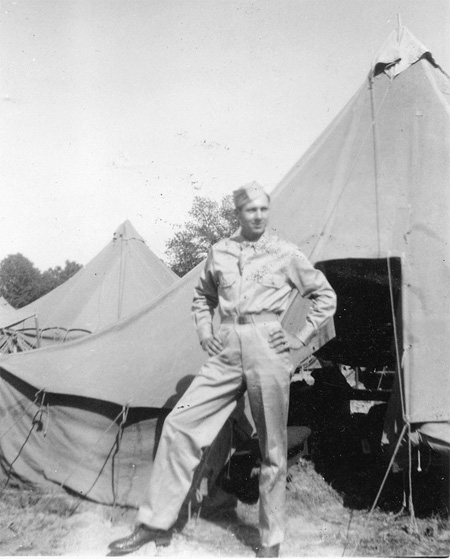
Member of the 11th Evacuation Hospital in front of a M-1934 Pyramid Tent (khaki-colored canvas), taken while the unit was bivouacking at the A. P. Hill Military Reservation, Fredericksburg, Virginia (US Army Maneuver area). Photo taken September 1942.
Stations, Zone of Interior – 11th Evacuation Hospital
Indio, California – April 22, 1942 > August 20, 1942 (Desert Training Center)
Freda, California – August 20, 1942 > August 27, 1942
A. P. Military Hill, Virginia – September 5, 1942 > October 12, 1942 (Maneuver Area)
Camp Kilmer, New Jersey – October 12, 1942 > November 1, 1942 (Staging Area)
July 11, 1941, the organization moved to Prescott, Arkansas, for participation to Second United States Army and General Headquarters Maneuvers (GHQ, organization established in July 1940 to supervise the training of field forces, including hospitals and medical units –ed), where it was eventually joined by members of the 10th Evacuation Hospital (activated 10 Feb 41, stationed at Fort Knox, Kentucky, embarked 4 Mar 42 for Australia –ed), plus personnel from the 68th and 110th Medical Regiments. The Hospital set up at the Prescott High School and a contiguous field. Second United States Army (with Headquarters in Memphis, Tennessee) was reactivated October 1, 1933 under a plan developed by Army Chief of Staff Douglas MacArthur to consolidate forces in the continental United States under four regional Army Commands. In 1940, with the activation of Army General Headquarters (succeeded by Army Ground Forces 9 Mar 42), the four field Armies were given responsibility for training forces in their respective areas and conducting maneuvers to evaluate training and readiness. With First and Fourth US Armies being given primary responsibility for defense of the eastern and western coasts of the United States, and later with FUSA’s relocation to England to command US Army Forces in preparation for the Invasion of the continent, Second and Third United States Armies assumed increasing responsibility for the training and organization of the rapidly expanding US Army and preparing troops for overseas deployment. When Third US Army Headquarters was relocated to France in 1944 to serve as a combat command, Second US Army assumed its stateside responsibilities as well.
Between August 10 – 14, 8 Nurses joined the Hospital. On August 11, 1941, the first patients were admitted and on September 4, all patients were evacuated in view of moving to a new location. Via rail, it went to Jonesboro, Louisiana for scheduled maneuvers and training of more cadre which had been assigned to the unit. During the following maneuvers, a total of 5,542 patients had been admitted, and the hospital treated a wide variety of disease and injury, including venereal disease, malaria, diphtheria, mumps, snakebites, scarlet fever, meningitis, scorpion stings, and diarrhea. At 1800 hours, October 13, 1941, the 11th Evac, having traveled 211 miles, was back in Camp J. T. Robinson. Following the end of the maneuvers, all TD personnel were sent back to their parent organizations and a large percentage of the draftees were transferred to the Enlisted Men Reserve.
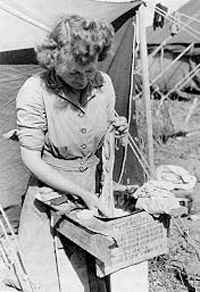
Army Nurse doing some personal washing in a steel helmet. Photo taken in French Morocco, some time in April 1943.
Until August of 1942, the unit continued training and preparing at Camp Joseph T. Robinson for a possible move overseas.
Preparation for Overseas Movement:
After receiving the necessary orders preparatory to a movement overseas, the unit entrained for Camp Kilmer, Stelton, New Jersey on October 12, 1942 (Staging Area for New York Port of Embarkation: acreage; 1,815, troop capacity; 2,074 Officers & 35,386 Enlisted Men –ed).
After due preparation and processing, the 11th Evac embarked with destination North Africa November 2, 1942. The Hospital traveled on board the troop transport “Monterey”, moving in convoy to the Mediterranean.
North Africa:
The organization arrived in North Africa November 18, 1942, where it was to subsequently serve in French Morocco and Tunisia. It landed together with the 750-bed 8th Evacuation Hospital (activated 8 Aug 42, affiliated to University of Virginia, Charlotte, embarked 2 Nov 42 for N. Africa –ed) which opened three days later in buildings of the Italian Consulate in Casablanca. The 11th Evac Hosp however, proceeded to Rabat, where it opened on December 8, 1942. Other units such as the 59th Evacuation Hospital (another 750-bed hospital, activated 12 Jan 42, affiliated to San Francisco Hospital, embarked 12 Dec 42 for N. Africa –ed) began receiving patients under canvas in Casablanca on December 30, while the 400-bed 91st Evacuation Hospital (activated as 6th Surg Hosp 1 Aug 40, redesignated 91st Evac Hosp 31 Aug 42, embarked 12 Dec 42 for N. Africa –ed) was established in the Port-Lyautey area where it admitted its first patients on February 2, 1943. It should be noted that these hospitals functioned as fixed installations (Station Hospitals –ed) rather than as mobile units.
During its stay in North Africa and later Sicily, the unit was commanded by Colonel Raymond D. Scott, MC.
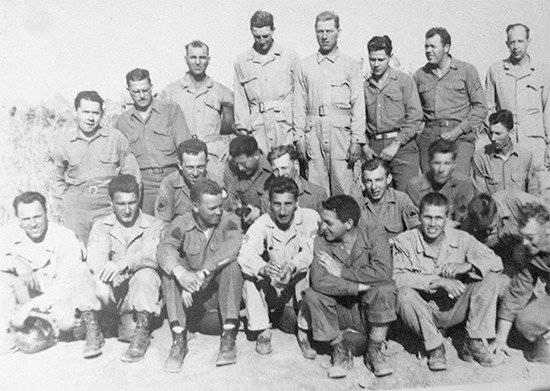
Group photograph showing Enlisted personnel of the 11th Evacuation Hospital. The photograph was likely taken during the unit’s time in North Africa.
Photo courtesy David Lawrence
The organization started 1943 with a staff of 42 Officers and 293 Enlisted Men, but no Nurses. An x-ray specialist joined the Hospital unit in March of 1943. March 18, 1943, 48 Nurses arrived, but their numbers eventually decreased to 40 ANC Officers because of a certain overstrength.
During the Allied advance into Tunisia, April 1943, Tabarka in northern Tunisia, served as the nerve center for II Corps medical activities. As a consequence of the German collapse and withdrawal from southern Tunisia, Allied troops now adopted a change in direction progressing to the north, and the 11th Evacuation Hospital was therefore shifted more than a thousand miles from Rabat, French Morocco, to a new site nine miles south of Tabarka. The 48th Surgical Hospital (activated 10 Feb 41, embarked 2 Aug 42 for England, previously located at Arzew, Algeria, since November 9, 1942 –ed) also moved and established its installations some ten miles further east. On April 21, 1943 the 15th Evacuation Hospital (activated 1 Jun 41, embarked 7 Feb 43 for N. Africa –ed) left Sbeïtla for a new location some ten miles north of Bédja, Tunisia, and the following day, the 11th relieved the 48th Surgical Hospital which closed for reorganization (reorganized and redesignated 128th Evacuation Hospital May 1, 1943 –ed). The 38th Evacuation Hospital (activated 16 Apr 42, affiliated to Charlotte Memorial Hospital, North Carolina, embarked 5 Aug 42 for England –ed) moved from Télergma Airfied, west of Constantine, Algeria, to the vicinity of Bédja, eventually followed by the 9th Evacuation Hospital (activated 24 Aug 42, affiliated to Roosevelt Hospital, New York, embarked 26 Sep 42 for England –ed) which set up in the vicinity of Mateur, Tunisia. Another medical unit, the 77th Evacuation Hospital (activated 10 May 42, affiliated to University of Kansas, embarked 5 Aug 42 for England –ed) remained throughout the Tunisian campaign at Morris (east of Bône).
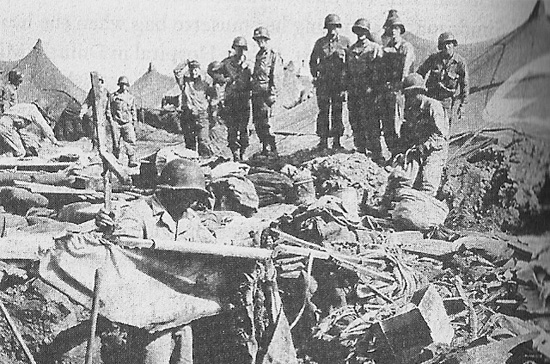
Bomb damage at the 56th Evacuation Hospital caused by enemy shelling, while the unit was operating on the Anzio Beachhead, 12 February 1944
Stations, North Africa – 11th Evac Hospital
Casablanca, French Morocco – November 18, 1942 > December 8, 1942
Rabat, French Morocco – December 8, 1942 > April 3, 1943
Tabarka, Tunisia – April 15, 1943 > April 22, 1943
Ouchatata, Tunisia – April 22, 1943 > May 31, 1943
Mateur, Tunisia – May 31, 1943 > June 2, 1943
Ferryville, Tunisia – June 2, 1943 > July 8, 1943
Bizerte, Tunisia – July 8, 1943 > July 13, 1943 (Staging Area)
The 11th Evac would end 1943 with an aggregate staff of 37 Officers, 39 Nurses, and 247 EM.
Sicily:
Before a successful assault against Sicily could be contemplated, a heavily-fortified Italian Air Base on the Island of Pantelleria had to be captured. After severe bombing by air and naval forces the Island surrendered to the Allies June 11, 1943. This operation was followed by the invasion of the Island of Lampedusa, which capitulated June 12, 1943. The other islands including Linosa (captured June 13) and Lampione (captured June 14) were quickly and successfully overcome by small Allied naval parties, opening the way for the joint Allied assault on Sicily with American – British – and Canadian forces.
After the “Joss Force” crossed the Strait of Sicily from the Tunisian ports in LSTs, the assault troops landed against little opposition at Licata on July 10, 1943, and managed to clear the town the first day, launching combat patrols four or five miles inland. Casualties were brought directly to the naval beach installations until Clearing Stations could be set up on D+1. Congestion on the beaches however prevented unloading of equipment causing the hospitals to delay installation, leaving elements of the 56th Medical Battalion to handle evacuation from the island. The 11th Evac departed Bizerte July 13, 1943 on board LST 357. By July 15, it opened northwest of Licata, while the 10th Field Hospital operated in town. As local hospital facilities were inadequate, Seventh US Army and II Corps were called upon to help, yet in the landing phase and during the following days medical supplies and beds could be spared to treat emergency cases only. Lt. Colonel Matthew C. Pugsley, MC (3d Infantry Division) was the “Joss Force” Surgeon. The 10th Field Hospital, one Platoon of the 11th Field Hospital and the 11th Evacuation Hospital were to provide medical support to the three US Divisions serving under Maj. General Geoffrey Keyes. The organization moved from Licata July 21, up to Agrigento, approximately sixty or more miles to the rear. Medical units including Field and Evacuation Hospitals followed closely behind combat forces, and were sometimes ahead of the Clearing Stations. A concentration was built up in the vicinity of Nicosia, five to fifteen miles behind the Troina front, grouping the 15th Evacuation, the 11th Field, and the 11th Evacuation Hospitals. Leapfrogging continued with Platoons of the 11th Field advancing toward Cesaro and Randazzo.
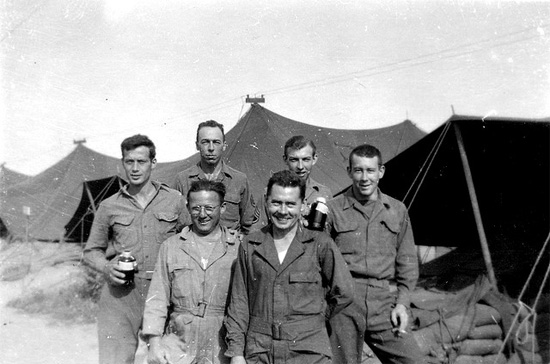
Photo illustrating some laboratory personnel of the 11th Evacuation Hospital while established at Anzio, Italy, in April 1944.
When fighting in Sicily and more particularly over roadless mountains, some difficulties were experienced with evacuation of the wounded. As litter bearers were the only means to bring the casualties to the various Aid Stations, mules were either requisitioned or purchased from local farmers to carry litters (as had been done in Tunisia). Care and management of the animals was handled by the 9th Infantry Division Veterinary Officer and his assistants. Due to road demolitions or lack of roads, and long litter hauls (sometimes close to 7 hours) well organized with necessary relays and stationed at intervals, it became possible to evacuate casualties from precarious positions in mountainous terrain. Slightly wounded men were often evacuated sitting on pack mules, while the more severe cases were carried by tandem or singles mules, or brought down by enemy PW details. Horses and pack animals suffered with quite a few animals becoming battle casualties. Lines of evacuation fluctuated with the progress of the campaign. Until late July of 1943, ambulances and trucks carried the bulk of the casualties to either the 93d Evacuation Hospital (activated as 61st Surg Hosp 1 Jun 41, redesignated 93d Evac Hosp 25 Aug 42, embarked 16 Apr 43 for N. Africa –ed), serving II Corps at Gela, or the 11th Evacuation Hospital at Licata, and later at Agrigento, serving the Provisional Corps. After capture of Palermo, Sicily, the city became the focal point for medical evacuation to North Africa, which took place by Hospital Carriers or by LSTs. After July 14, primitive and occasional air evacuation was begun from airfields around Gela and Licata. The 802d Medical Air Evacuation Transport Squadron took over operations from July 16 onward, initially flying out of Agrigento, later out of Castelvetrano, and finally out of Palermo. Such flights were provided with a Flight Nurse and a Medical Technician to accompany the patients during their evacuation. Sea evacuation was handled by 2 American (USAHS “Acadia” and USAHS “Seminole” –ed) and 3 British Hospital Ships assisted by 5 British Hospital Carriers (5,967 men were evacuated by air and another 5,391 by sea from Sicily –ed). At the time, 4 Officers, 60 Nurses, and 88 Enlistee Men were serving on Sicily.
It should be noted that although the medical personnel were supposed to follow the advancing infantry, they sometimes beat them. This resulted in Nurses digging foxholes while being bombed, and surviving on rations with no water except in their canteens, and temporarily sleeping in pup tents, until their equipment and friendly forces caught up with them.

Illustration showing the unit sign of the 11th Evacuation Hospital.
Photo courtesy David Lawrence
Stations, Sicily – 11th Evacuation Hospital
Licata, Sicily – July 15, 1943 > July 22, 1943
Agrigento, Sicily – July 22, 1943 > August 5, 1943
Nicosia, Sicily – August 6, 1943 > August 13, 1943
Santa Agatha, Sicily – August 13, 1943 > August 21, 1943
Cefalu, Sicily – August 21, 1943 > November 24, 1943
Mondello Beach, Sicily – November 24, 1943 > January 3, 1944 (Staging Area)
Messina, Sicily – January 4, 1944 > January 5, 1944
Bagrana, Sicily – January 5, 1944 > January 6, 1944 (Staging Area)
Praia A. Maria, Sicily – January 6, 1944
The 11th Evacuation Hospital, operating as a Station Hospital was still assigned to Seventh United States Army, although under control of the Island Base Section (IBC). November 6, 1943, the organization was redesignated 11th Evacuation Hospital, Semimobile. It remained in Palermo from November 23, 1943 until December 31, 1943, and closed for patients December 31, starting preparations for a move to the Italian mainland.
Italy:
The 11th Evac arrived from Sicily to open at Vairano, Italy, January 14, 1944, where it replaced the 95th Evacuation Hospital earmarked for the Anzio operation. Leaving Casanova it later also moved to the Anzio Beachhead April 15 in order to change places with the 93d Evacuation Hospital which had been hard hit by German artillery, opening for admission of patients the following day (personnel moved partly by train to Naples and by LST to Anzio). American and British Hospitals were rotated as much as possible in order to try and reduce the number of casualties and general damage to the hospital area. Through the coordinated work of personnel and engineers, most of the hospitals were either dug in or received additional protection consisting of wooden planks and sandbags. The 36th Engineer Regiment (which landed January 22) excavated 3½-foot foundations for the hospital tents and reinforced them with protective earthworks, wooden beams, and sandbag walls to protect patients and medical personnel from flying shrapnel and incoming shells, although not from direct hits. Sporadic enemy bombing and shelling continued, as it was impossible to put the medical installations out of range. The beachhead was approximately 15 miles wide and 7 miles deep, allowing no possible retreat, the congested area was therefore nicknamed ”Hell’s Half Acre”. It must be noted that from January 22, 1944 through May 22, 1944, the hospitals located at Anzio admitted over 48,000 casualties, cared for 33,128 patients, of whom 10,809 suffered from battle wounds, 4,245 from injuries, and 18,074 from miscellaneous disease.

Wounded American and Allied casualties on board a British Hospital Carrier awaiting evacuation from the Anzio Beachhead. Photo taken course of February-March 1944. The patients were taken to the beach, placed on landing craft, and taken out to the Mediterranean where British Hospital Ships and Carriers were waiting. The staff consisted of Medical Officers of the Royal Army Medical Corps (RAMC), and Nurses/Sisters of Queen Alexandra’s Imperial Military Nursing Service (QAIMNS), supported by RAMC Technicians.
Following the realignment of the Allied Armies in Italy, a number of medical installations were accordingly moved to new positions, with patients evacuated to hospitals in the Caserta area, since the Naples hospitals were largely reserved for Anzio casualties and those from the French Expeditionary Corps. All Fifth US Army Hospitals were more or less regrouped in the vicinity of Carinola about twelve miles east of the mouth of the Garigliano River. Opening May 11, 1944, the organization was followed by the 3d Evacuation, 8th Evacuation and the 95th Evacuation Hospitals.
After the fall of Rome the Allied Chiefs of Staff gave higher priority to expanding their operations in France. VI Corps and the French Expeditionary Corps, including a number of medical units were therefore transferred to Seventh US Army. Personnel was being gradually removed from the frontlines between June and July, and the 11th, together with the 93d and 95th Evacuation Hospitals, were withdrawn from Fifth Unites States Army attachment around mid-July 1944 in view of the coming Southern France Invasion.
Stations, Italy – 11th Evacuation Hospital
Naples, Italy – January 7, 1944 > January 10, 1944 (Staging Area)
Vairano, Italy – January 12, 1944 > March 10, 1944
Casanova, Italy – March 10, 1944 > April 15, 1944
Anzio Beachhead, Italy – April 16, 1944 > June 10, 1944
Santa Marinella, Italy – June 10, 1944 > July 14, 1944
Sparanese, Italy – July 14, 1944 > July 26, 1944
Qualiana, Italy – July 26, 1944 > August 10, 1944 (Staging Area)
Southern France:
The 11th Evac began the month of August in a Staging Area north of Naples, Italy, preparing for a movement by water. All organizational equipment was loaded on several ships accompanied by the Officers and the EM, except for the Nurses who were moved into a Nurses’ Staging Area to join the unit at a later date. The remaining personnel boarded USAT “George O. Squire” on August 10, 1944, with planned debarkation on August 15, near Dramont.

Partial view illustrating ships of the invasion fleet at anchor off the beaches of Southern France. Photo taken August 16, 1944.
The Invasion of Southern France was one of the most successful landings with beaches secured and initial objectives captured within a period of thirty-six hours. The “Camel” Attack Force landing August 15, 1944 comprised the following medical units and elements: the 111th Medical Battalion (36th Infantry Division), the 885th – 886th – 887th Medical Collecting Companies (56th Medical Battalion) and the 891st Medical Clearing Company, First Platoon of the 638th Medical Clearing Company (164th Medical Battalion), First + Third Hospitalization Units (11th Field Hospital), 7 Teams pertaining to the 2d Auxiliary Surgical Group and the 11th Evacuation Hospital.
The 11th was not set up and functioning until August 17; its first sixteen days being occupied in temporary bivouac areas and aboard the troop transport.
The two Platoons of the 11th Field and the 11th Evac landed together at 1900 hours, going into bivouac near the landing area, east of St. Raphaël, and eventually following the 36th Infantry Division’s Clearing Station to Le Muy on August 17, going into operation the following morning providing extra assistance to the 676th Medical Collecting Company (164th Medical Battalion) which constituted the basic medical support for the First Special Service Force (with attached Team of the 2d Aux Surg Gp). It was at this area that the Nurses rejoined the unit. On August 25, 1944 the 11th Evacuation Hospital opened in the vicinity of Aspres, sixty-five miles to the rear. At first supplies of all kinds were hard to obtain due to the rapid movement of the Army.
Most hospitals moved by echelons, but the major problem was securing the necessary trucks to accomplish the moves, which had to be borrowed from Seventh US Army, when available. Consequently hospitals were often overcrowded and when moving forward it was sometimes necessary to leave holding units behind to care for non-transportable patients. An Air Evacuation was established at Sistéron, relieving the critical situation and cutting down the distance of evacuation to 30 miles on all non-transportable patients. The German PWs were meanwhile evacuated to a captured German hospital at Draguignan and Aix, France, staffed by both American and German medical personnel. Civilian personnel, including enemy PW details were used in various capacities, the most frequent being as litter bearers. The organization moved ahead from Le Muy toward Aspremont, a leap forward close to 128 miles, in support of the troops fighting from Montélimar to Crest. After evacuating its 300 patients, dismantling the installations, and packing its equipment, it was on the road to its new site.
On August 22, 1944 the organization received a new Commanding officer, Colonel C. P. Ward, MC, O-19314, who joined from Headquarters, Seventh United States Army, relieving Lt. Colonel John H. Taber, MC, O-20987, the latter being transferred to Headquarters, Seventh US Army.
The 9th Evacuation Hospital was sent to support the 11th setting up at Beaumont, and opening at 0800 hours, August 28. By August 31, Seventh US Army had advanced quite rapidly with patrols probing at the Italian border, and others at the Spanish border, while the enemy was fighting rearguard actions as it tried to slip through the narrow gap between Seventh and Third United States Armies. The speed of the advance up to late September of 1944 necessitated long and frequent moves, with advance reconnaissance parties exploring the frontlines in search of potential hospital sites.

Inside view of one of the 11th Evacuation Hospital ward tents, in Southern France. Photo taken August-September 1944.
Patients Received and Treated at Le Muy – 11th Evacuation Hospital (Aug 44)
American – 720
British – 80
French – 23
German/Italian PW – 204
Patients Received and Treated at Aspremont – 11th Evacuation Hospital (Aug 44)
American – 1,015
British – 2
French – 32
German PW – 93
On September 9, the Hospital closed its location south of Aspremont. Another move forward was made on September 11 in two echelons, entrucking on the organizational transportation plus 12 2½-ton trucks borrowed from the 93d and 95th Evacuation Hospitals, and after moving to St. Amour, for an overnight bivouac, the unit opened at Aissey, some fifteen miles east of Besançon, which represented a 265-mile journey from Aspremont. This spectacular move required borrowing a number of trucks which in a first echelon succeeded in carrying 300 cots, all surgical Nurses, and half the Officers of both the Surgical and Medical Services. The remainder of the personnel arrived with the second echelon. This action allowed the Hospital to admit 158 patients during the first five hours following its opening. On September 17, 1944, the facility closed and all patients were evacuated by 1700 hours, September 19. On September 20, the organization moved to a new site one mile east of Conflans, which represented traveling a distance of 62 miles. Within three hours from arrival, the unit was ready to receive patients.
During the last two weeks of the month, continuous rain and cold hampered movements and operations. Tents had to be ditched and access roads graveled, and with inadequate heating, it was often difficult to keep patients warm. Trench foot made its appearance toward the end of September and soon became an increasingly severe problem the following months. Between August 15 and September 29, 1944, Seventh US Army medical installations admitted and treated 28,128 patients, of whom 320 died in hospital, 13,075 were evacuated to ComZ facilities, and 9,384 returned to duty.
Patients Received and Treated at Aspremont – 11th Evacuation Hospital (Sep 44)
American – 237
French – 6
German PW – 6
Other – 5
Patients Received and Treated at Assey – 11th Evacuation Hospital (Sep 44)
American – 763
French – 15
German PW – 129
Other – 6
Patients Received and Treated at Conflans – 11th Evacuation Hospital (Sep 44)
American – 925
French – 12
German PW – 154
Other – 8

Partial view of the 11th Evacuation Hospital’s laboratory in the field, housed in either a storage or a large wall tent.
On October 15, 1944, all the patients remaining at the unit’s installation near Conflans were evacuated. The 11th’s first echelon traveled by motor convoy the following day, reaching its new location one and a half mile northeast of Bayon, France. To enable this move, 14 additional trucks plus drivers were borrowed from the 9th, 93d and 95th Evacuation Hospitals. Because of the weather arrangements were made with the Engineer Section, Seventh US Army, to build ambulance drives and lay out a system of drainage. This work was done before the vehicles unloaded and was found to be much more practical.
Patients Received and Treated at Conflans – 11th Evacuation Hospital (Oct 44)
American – 449
French – 23
German PW – 43
Others – 7
Patients Received and Treated at Bayon – 11th Evacuation Hospital (Oct 44)
American – 777
French – 107
German PW – 53
Other – 7
The 11th Evacuation Hospital was eventually transferred and came under control of the European Theater authorities on November 1, 1944. On November 20, 1944 all Communications Zone functions in Southern France passed finally from MTO to ETO jurisdiction.
On November 25, 208 of the 278 remaining patients were evacuated preparing for another move. On November 26, 51 of the remaining 70 patients were evacuated, necessitating that a small detachment of a few Officers, Nurses, and Enlisted personnel remain behind with the seriously-ill patients whose condition would not permit evacuation. The same day, approximately one half of the hospital organization traveled by motor convoy to a new installation site located at Lorquin, France, which represented a distance of 42 miles.
The new location provided the Hospital with quarters in fixed buildings (the first since being overseas –ed). They were part of a French Psychiatric Hospital and were very suitable for all the needs. After moving into the buildings at 1100 hours, the 11th was ready to receive patients at 2100 hours the same date.
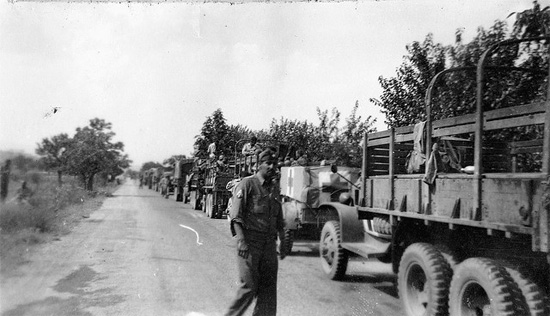
Motor convoy of the 11th Evacuation Hospital on the move to St. Amour, where a night bivouac was set up on September 10-11, 1944.
Patients Received and Treated at Bayon – 11th Evacuation Hospital (Nov 44)
American – 1,013
French – 224
German PW – 133
Other – 16
Patients Received and Treated at Lorquin – 11th Evacuation Hospital (Nov 44)
American – 344
French – 60
German PW – 23
Other – 5
The 11th Evac Hosp began the month of December 1944 at its location at Lorquin, France where it remained the whole month. It was winter and a welcome change to be set up in buildings and during the severe cold weather, the central heating plant kept the temperature in the different sections and wards very comfortable.
Patients Received and Treated at Lorquin – 11th Evacuation Hospital (Dec 44)
American – 1,857
French – 35
German PW – 24
Other – 19
The organization remained another month at Lorquin with their stay becoming the longest in one site since landing in France, August 15, 1944.
Patients Received and Treated at Lorquin – 11th Evacuation Hospital (Jan 45)
American – 2,659
French – 99
German PW – 139
Other – 6

Temporary stop of the 11th Evacuation Hospital convoy on the road to Besançon, en route for their hospital site at Aissey, where the organization opened September 11, 1944.
The Hospital spent another month in the same location, enjoying buildings and the advantageous arrangement they presented.
The 11th Evac was awarded the “Meritorious Service Unit Plaque” on February 27, 1945 by the Surgeon, Seventh United States Army for the Commanding General, Seventh US Army, for outstanding devotion to duty in the performance of exceptionally difficult tasks for the period August 16 1944 to November 30, 1944, in France.
The month of February 1945 received the smallest number of patients since landing in Southern France.
Patients Received and Treated at Lorquin – 11th Evacuation Hospital (Feb 45)
American – 867
French – 6
German PW – 81
Other – 8
The 11th Evacuation Hospital started the month of March in the same location in the French Psychiatric Hospital, at Lorquin, France. After receiving instructions, it officially closed on March 25, evacuating all remaining patients preparatory to a new move. The first truck convoy departed the following day, reaching a bivouac site at Göllheim, Germany, where it was to await crossing of the River Rhine. On March 28, the last of the shuttling of equipment was completed, with the trucks being reloaded immediately for a quick move of the first echelon across the Rhine. It moved on March 29, arriving at the R-V point, one mile east of Lorsch, Germany.
After unpacking and pitching the large variety of tentage, the installation officially opened at 1600 hours, the same day, 23 patients being admitted before 2400 hours.
Patients Received and Treated at Lorquin – 11th Evacuation Hospital (Mar 45)
American – 1,189
French – 4
German PW – 66
Other – 24

Distant view of the 11th Evacuation Hospital in the process of setting up at Conflans, September 20, 1944.
Stations, France – 11th Evacuation Hospital
Dramont, France – August 15, 1944 > August 17, 1944
Le Muy, France – August 18, 1944 > August 24, 1944
Aspremont, France – August 25, 1944 > September 10, 1944
St. Amour, France – September 10, 1944 > September 11, 1944
Aissey, France – September 11, 1944 > September 20, 1944
Conflans, France – September 20, 1944 > October 15, 1944
Bayon, France – October 16, 1944 > November 26, 1944
Lorquin, France – November 26, 1944 > March 26, 1945
Germany:
After opening for the first time in Germany on March 29, 1945, the unit performed the normal functions of an operating hospital. On April 6, 178 out of the 197 remaining patients were evacuated. On April 7, 1945, the first echelon entrucked for a new change of site, in the vicinity of Lauda, Germany, a distance of approximately 77 miles. A small detachment was detailed to remain with the 19 seriously-ill patients, until they too could be evacuated.
On April 26, 109 of the remaining 135 remaining patients were evacuated, leaving only 26 ill patients that could not be transported. The Hospital moved in two echelons, the first one traveling on April 27 to a new hospital site at ¼ mile southeast of Schabringen, Germany, a distance of 123 miles further into Germany.
First Patients Received and Treated at Lorsch, Germany – 11th Evacuation Hospital (Mar 45)
American – 125
French – 0
German PW – 24
Other – 9

Partial view of the 11th Evacuation Hospital, while established at Lorquin, France, where it spent the winter from November 26, 1944 to March 26, 1945 inside buildings.
The month of April was one of the fastest moving frontline where the most important factor was to keep the Hospital in close contact with the combat troops.
Patients Received and Treated at Lorsch – 11th Evacuation Hospital (Apr 45)
American – 221
Allied – 4
German PW – 51
Other – 6
Patients Received and Treated at Lauda – 11th Evacuation Hospital (Apr 45)
American – 1,406
Allied – 46
German PW – 317
German Civilian – 28
Patients Received and Treated at Schabringen – 11th Evacuation Hospital (Apr 45)
American – 201
Allied – 11
German PW – 14
German Civilian – 1
Preparatory to a move, the 11th evacuated 93 of the 127 remaining patients on May 21, with the first echelon comprising about half the Hospital moving by motor convoy to a new location one mile southeast of Augsburg, Germany, a distance of only 35 miles. The last remaining 30 cases were transported to the new hospital site the following day, May 23, 1945.

Ongoing maintenance and repair work carried out by personnel of the 11th Evacuation Hospital.
May 1945 saw the end of the hostilities in the European Theater of Operations, consequently battle casualties were very light with the majority of patients admitted being of disease or injury classification. The breakdown was as follows:
Patients Received and Treated at Schabringen – 11th Evacuation Hospital (May 45)
American – 840 (only 78 battle casualties)
Allied – 74
German PW – 53
German Civilian – 18
Patients Received and Treated at Augsburg – 11th Evacuation Hospital (May 45)
American – 112 (no battle casualties)
Allied – 2
German PW – 0
German Civilian – 1
From July 23 to August 24, 1945 inclusive, the 11th Evac was located in Weinheim, Germany (bivouac). During this period training schedules were held throughout each day as the personnel awaited redeployment to the Zone of Interior and usual garrison routine prevailed.
When the war with Japan ended, the status of the unit changed from one going home to one going into operation relieving a Category IV unit that would ultimately be returned to the United States.
Having lost most of its Medical Officers through transfers and redeployment it was necessary to have a number attached for TD. On August 25, 1945, the unit relieved the 26th Field Hospital in Rheinau, Germany, in a school building that had been converted into a station hospital site and the remainder of the month was spent in operation.

Official sign with DI of the 11th Evacuation Hospital in front of the unit’s premises while stationed at Lorquin, France, in winter 1944-1945.
Upon relieving the 26th Field, a transfer of 139 patients was involved, while admissions reached 155 with an outpatient total of 81.
In September 1945, the Hospital was still located in Rheinau, Germany, utilizing a school building to operate as a Station Hospital. During the month of September, a total of 546 admissions were registered with an outpatient figure of 547.
Readjustment of personnel continued during the month with considerable turnover, without affecting the organization’s function.
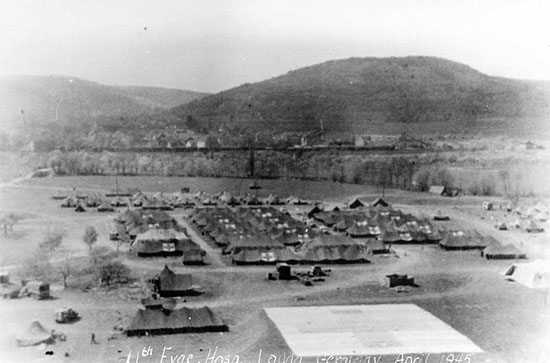
Partial aerial view of the 11th Evac Hosp complex in Lauda, Germany. Photograph taken in April 1945.
Information was received the last week of September 1945 that the 137th Evacuation Hospital was going to relieve the unit and an advance party arriving that week confirmed same. Coordination between the 2 Hospital Headquarters continued throughout the change-over until completion.
In view of the readjustment policy and forthcoming cessation of operations by the unit, the current CO was relieved of his assignment and Lt. Colonel John F. Conlin, MC, assumed command of the 11th Evacuation Hospital.
Operating only three (3) days in October, the organization was effectively relieved by the 137th Evac Hosp on October 4, 1945 and 7 Officers and 171 Enlisted Men (attached from other units) were transferred to the Detachment of Patients, 137th Evacuation Hospital, October 3, 1945.
Immediately upon being relieved and throughout the remainder of the month, personnel were joining and others departing from the 11th during the Readjustment process. All the Nurses were transferred out and only 9 Medical Officers and 162 EM remained in the organization.
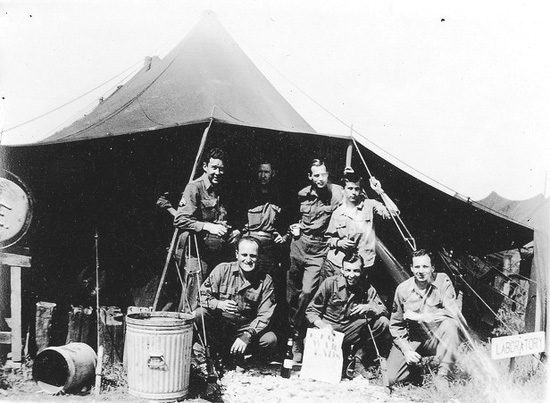
Scene illustrating lab personnel of the 11th Evacuation Hospital in front of an M-1934 pyramid tent celebrating V-E Day, May 8, 1945, in Dillingen, slightly south of Schabringen, Germany.
Owing to the Redeployment of units being delayed, the 11th Evac continued to billet at the 137th Evac Hosp awaiting the vacation of the requisitioned billets. Meanwhile a new training program was being carried out to keep the personnel busy; pass and leave continued frequently.
(the authors are still looking for any information related to the end of the unit’s stay in Germany, and its eventual return to the Zone of Interior).
Stations, Germany – 11th Evacuation Hospital
Göllheim, Germany – March 26, 1945 > March 28, 1945
Lorsch, Germany – March 29, 1945 > April 7, 1945
Lauda, Germany – April 7, 1945 > April 27, 1945
Schabringen, Germany – April 27, 1945 > May 22, 1945
Augsburg, Germany – May 22, 1945 > July 22, 1945
Weinheim, Germany – July 23, 1945 > August 24, l945
Rheinau, Germany – August 25, 1945 > October 4, 1945
Unit Awards – 11th Evacuation Hospital
Meritorious Service Unit Award Insignia + Unit Plaque– General Orders # 54, Headquarters,
Seventh United States Army,
dated 16 February 1945
Official Campaign Credits – 11th Evacuation Hospital
Tunisia
Sicily
Naples-Foggia
Rome-Arno
Anzio
Southern France
Official Campaign Participation Awards – 11th Evacuation Hospital
Miniature Bronze Stars on the European, African Middle Eastern Theater Ribbon:
Southern France – dated October 18, 1944
North Africa – dated 10 November 1944
Rhineland – dated 5 February 1945
Central Europe – dated 21 June 1945
Miniature Bronze Arrowhead:
Southern France – dated 26 May 1945
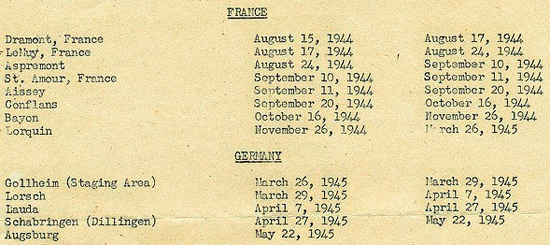
Itinerary of the 11th Evacuation Hospital illustrating its subsequent stations while traveling through France and Germany.
Note: the 11th Evacuation Hospital was reactivated at Fort Hood, Texas, May 2, 1949, under Colonel W. H. Glascock. The unit consisting of Texas and Oklahoma Reservists embarked on an intensive period of training which lasted until January 1951. Almost one month later, it sailed for Japan, to prepare for duty in Korea, where it eventually arrived on May 3, 1951. The Hospital officially closed for operations September 7, 1953, after admitting over 28,000 patients.
Personnel Roster: (incomplete)

Photograph showing Noncommissioned Officers of the 11th Evac Hosp.
First row, left to right: Cpl. Milo S. Moe, T/5 Gene Mayer, T/Sgt R. V. Krause.
Back Row, left to right: Cpl. Jerome J. Lawrence and Sgt. Russell Jenning.
Photo courtesy David Lawrence
Officers:
| Barah, Charles E. (Capt) | Flesher, Richard L. (1st Lt) | Read, Jesse W. (Capt) |
| Brennan, William F. (Lt Col) | Forsythe, James R. (1st Lt) | Schwartz, Harold B. (1st Lt) |
| Brethouwer, Norman A. (Capt) | Forsythe, James R. (Capt) | Scott, Raymond D. (Col) |
| Brown, Alton B. (Capt) | Gallagher, Brian J. (Capt) | Sharpe, Luther E., Jr. (1st Lt) |
| Buckley, WIllard E. (Capt) | Gordon, Orville E. (Capt) | Smith, Bruce H. (1st Lt) |
| Burk, Cecil E. (Capt) | Hayton, Donald W. (1st Lt) | Smith, Robert W. (Lt. Col) |
| Campbell, Charles M., Jr. (1st Lt) | Hoover, Carl H. (Major) | Streck, William J. (WO1) |
| Casey, Robert F. (1st Lt) | Kilson, Kenneth R. (Capt) | Stuck, Ralph M. (Capt) |
| Clark, George E., Jr. (Capt) | Klabunde, Earl H. (1st Lt) | Stull, John D. (Capt) |
| Cleary, William J., Jr. (1st Lt) | Kornegay, Robert D. (Capt) | Stull, John D. (Capt) |
| Cline, Ross W. (1st Lt) | Lannon, James W. (Capt) | Taber, John H. (Maj) |
| Coffeen, Charles S. (1st Lt) | Leinweber, Arthur R. (Capt) | Turner, Wylie E., Jr. (Capt) |
| Collins, Ralph T. (Maj) | Leinweber, Arthur R. (Maj) | Vail, Harry F. (Capt) |
| Conlin, John F. (Lt. Col) | Madsen, Charles K. (1st Lt) | Wagner, David (Maj) |
| Copeland, Raymond F. (Chaplain) | McIntyre, James M. (1st Lt) | Wagner, David (Maj) |
| Dougherty, William O. (1st Lt) | McIntyre, James M. (Capt) | Ward, Charles P. (Col) |
| Doughterty, William O. (Capt) | McNair, Jack A. (Capt) | Wilcox, Keith E. (Capt) |
| Edwards, Edward A. (Capt) | Moser, Ernest C. (1st Lt) | Wilcox, Keith E. (Capt) |
| Elliott, William H., Jr. (Capt) | Ostrowski, Edward J. (1st Lt) | Wilson, Harold L. (Maj) |
| Fabian, Frank C. (Capt) | Pratt, Elmer B. (Capt) |
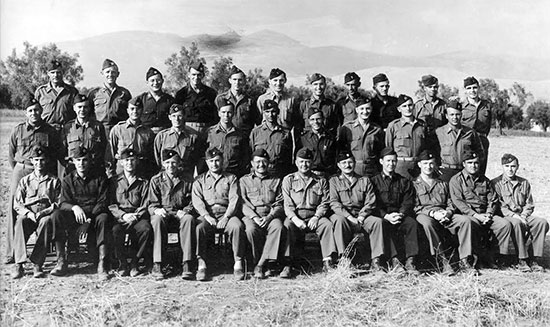
Group photograph showing Officers of the 11th Evacuation Hospital. Picture taken during the unit’s training phase in the Zone of Interior.
Nurses:
| Allinson, Ceilia (1st Lt) | Good, Dorothy L. (1st Lt) | Reiff, Ernesta C. |
| Anderson, Hilda E. (1st Lt) | Gorman, Helen M. (1st Lt) | Rich, Eleanor L. (1st Lt) |
| Backer, Frances B. (1st Lt) | Hardacre, Evelyn M. (1st Lt) | Rickert, Helen B. (1st Lt) |
| Backman, Winifred H. (1st Lt) | Hardacre, Marguerite | Rogers, Hilda E. (1st Lt) |
| Bender, Grago I. | Harlow, Emelyn O. | Scheckter, Muriel |
| Billings, Virginia (1st Lt) | Harrell, Isabel G. (1st Lt) | Schepper, Waunita V. (1st Lt) |
| Biola, Helen H. | Harris, Loretta V. | Schlem, Marcella G. (1st Lt) |
| Brown, Lucille E. (1st Lt) | Hubbard, Helen J. (1st Lt) | Short, Mary M. |
| Cisne, Ida M. (1st Lt) | Hunter, Elsie M. | Simon, Virginia J. (1st Lt) |
| Cleary, Kathleen M. (1st Lt) | Johnston, Charlotte I. | Smith, Doris E. (1st Lt) |
| Collier, Charlotte V. | Julian, Eva M. (1st Lt) | Smith, Frances K. (1st Lt) |
| Conway, Mary E. (1st Lt) | Kay, Helen M. (1st Lt) | Smith, Helen D. (1st Lt) |
| Cook, Elizabeth S. | Kierepka, Agnes E. (1st Lt) | Smith, Peggy L. |
| Cooke, Lillian I. | Knab, Lillian B. | Smith, Thelma J. (1st Lt) |
| Costello, Myrtle B. | Knapp, Imbi M. (1st Lt) | Steinkamp, Ruth A. (1st Lt) |
| Crawford, Barbara | Krueger, Wilma J. (1st Lt) | Taylor, Mildred E. (1st Lt) |
| Crossman, Catherina A. (1st Lt) | Ladeau, Agnes M. | Thomas, Evelyn M. (1st Lt) |
| Crosson, Diana B. (1st Lt) | LeFevers, Ilene E. (1st Lt) | Thornton, Margary R. |
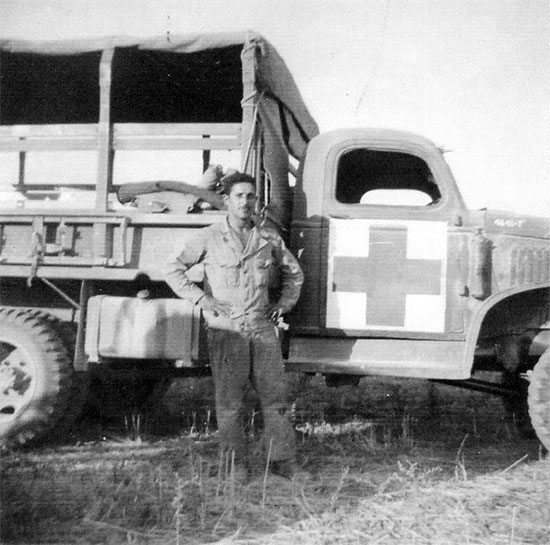
Driver J. D. Lloyd poses for the camera in front of a 2 1/2-ton Truck assigned to the 11th Evacuation Hospital. Of interest is the large Geneva Convention marking which has been applied to the door of the vehicle.
| Deeds, Anna M. | Ligas, Catherine D. | Troy, Ethel M. |
| Deming, Miriam A. | Madan, Anne M. (1st Lt) | Wandrey, June M. (1st Lt) |
| Dunning, Mirian | Mailloux, Margaret M. (1st Lt) | Warner, Gertrude E. |
| Field, Olive M. (1st Lt) | Maynard, Rita M. | Watson, Doris J. |
| Frauenholz, Barbara M. (1st Lt) | McElroy, Louise I. (1st Lt) | Wells, Mildred L. |
| Frayne, Annie D. (1st Lt) | Michel, Louise A. (1st Lt) | Winchester, Ida (1st Lt) |
| Freeland, Lora | Musser, Nellie C. | Woebbeking, Dorothy C. (1st Lt) |
| Frosh, Marjorie I. | Overberger, Cora C. | Woudem, Anne (1st Lt) |
| Gasline, Eleanor | Pfeffer, Henrietta H. | Zagajeski, Lillian (1st Lt) |
| Gilboy, Frances T. (1st Lt) | Pierce, Lois G. (1st Lt) | Zentmeyer, Beatrice E. |
| Glavey, Ruth C. (1st Lt) | Rannells, Bernice I. (1st Lt) |
Enlisted Personnel:
| Adoff, Jacob (Pfc) | Godfrey, Cornelius A. | O’Brien, John R. (Tec 3) |
| Anderson, Paul S. | Goldman, Louis (Cpl) | O’Donnell, Clement J. (Pfc) |
| Anderson, Warren P. | Goresth, Sanford R. (Tec 4) | O’Neal, Richard E. (Tec 5) |
| Arendall, William C., Jr. (Tec 5) | Goyette, Francis J. (Pfc) | Olsen, Frederick (Pfc) |
| Argust, Tom F. (Tec 5) | Greenleaf, Ralph C. (Tec 3) | Pace, Clayton E. (Tec 5) |
| Armstrong, Everett C. | Grillo, Michael P. (Pfc) | Parke, Thomas P. (Tec 4) |
| Atkins, Desmon | Guarino, Stephen J. (Pfc) | Parker, Melvin E. (Tec 3) |
| Badgett, Charter (Tec 5) | Guercia, Achille A., Jr. (Tec 4) | Peek, Chesley D. (Pfc) |
| Barbarisi, Edward J. (Sgt) | Hamilton, John W. (Tec 5) | Peiffer, Bernard M. (Tec 5) |

Group photograph showing Nurses of the 11th Evacuation Hospital during training in the ZI.
Front row, left to right: Loretta Harris, Cathleen Ligas, Mildred Wells, Margaret Mailloux, Charlotte Johnston, Eleanore Gasline, Charlotte Collier, Waunita Schepper, Muriel Scheckter, Marguerite Hardacre, Doris Watson, Annie Deeds.
Middle row, left to right: Helene Gorman, Henrietta Pfeffer, Mildred Taylor, Ernesta Reiff, Dorothy Good, Elizabeth Cook, Louise McElroy, Frances Gilboy, Diana Crosson, Anne Madan, Nellie Musser, Lucille Brown.
Back row, left to right: Emelyn Harlow, Virginia Billings, Frances Backer, Catherine Crossan, Eleanor Richey, Bernice Rannells, Lois Pierce, Marjory Frosh, Ida Winchester, Mirian Dunning, Olive Field, Barbara Fraunholz, Ilene LeFevers, Myrtle Costello, Dorothy Woebbeking.
| Bartelt, Kenneth C. (Tec 5) | Hansen, Arnold M. (Tec 5) | Perdue, James H. (Pfc) |
| Baumhover, Fred H. | Harkey, Henry R. (Sgt) | Peterson, Glenwood J. (Tec 4) |
| Baxter, Robert A. (Pfc) | Hart, Clifford H. (Pfc) | Piretti, Henry R. (Pfc) |
| Bento, Joseph (Tec 3) | Hauersperger, Leonard J. (Tec 4) | Pittenger, Robert C. (Tec 4) |
| Berens, Severin J. (Tec 5) | Hayes, Francis M. (Pfc) | Plassenthal, Ray F. (Pfc) |
| Bertelt, Kenneth C. | Henry, William E., Jr. (Pfc) | Poggenpohl, William E. (Tec 5) |
| Best, Robert E. (Pfc) | Hermanson, Philip E. (Tec 5) | Polansky, Nathan (Pfc) |
| Biggs, Clarence A. (Tec 5) | Herrick, Richard (Tec 4) | Przybylski, Stanley C. (Tec 4) |
| Billinger, Daniel (Tec 5) | Hill, Jack, Jr. (Tec 4) | Ramsey, Robert E. (Tec 5) |
| Boenig, William J., Jr. (Pfc) | Hilliard, Clarence O. (Tec 4) | Rea, Patsy D. (Tec 5) |
| Bohrer, Charles D. | Hobson, Mark L. (Tec 5) | Reilly, Roland E. (Tec 3) |
| Borick, Milan (Private) | Hohman, Arthur H. (T/Sgt) | Rice, Leland J. (Pfc) |
| Bost, Robert E. | Hopper, James A. (Tec 3) | Rizzo, Salvatore F. (Tec 5) |
| Boyle, James J. (Pfc) | Horak, Ralph G. (Tec 3) | Robson, Herbert E., Jr. (Pfc) |
| Brown, Charles E. (Tec 5) | Hornbeck, William S. (Tec 4) | Rose, William (Tec 5) |
| Brown, Walter I. (Tec 3) | Houser, Clarence D. (Pfc) | Rosenblatt, Emil (Pfc) |
| Bruno, Joseph (Pfc) | Hughes, Merlin F. (Tec 4) | Roughton, Roy W. (Tec 3) |
| Buchholz, William A., Jr. (Tec 4) | Hunzeker, Verne E. (Tec 4) | Rowles, William N. (Tec 5) |
| Buletti, Angelo (Pfc) | Jenning, Russell (Sgt) | Rubin, Paul P. (Pfc) |
| Burney, Donald C. (S/Sgt) | Johnson, Allan J. (Tec 3) | Rupe, Jack C. (Tec 5) |
| Burns, Leslie | Johnson, Melvin J. (Pfc) | Ryan, Leonard J. (Tec 5) |
| Burrows, John S. (Tec 4) | Jones, Harold E. (Tec 5) | Schmadeke, Edwin M. (Tec 3) |
| Burton, Jack A. (Cpl) | Keane, Edward J. (Tec 5) | Sedlak, Frank (Tec 4) |
| Caprefoli, William (Tec 3) | Kennedy, Daniel J. (Cpl) | Smith, Bruce H. |
| Carr, Arlie D. (Pfc) | Kierwiak, Joseph R. (Tec 4) | Smith, Donald R. (Tec 3) |
| Casey, Robert F. | Kirkeide, Melvin A. (Tec 5) | Smith, Warren E. (Tec 5) |
| Chaney, Starling F. (Tec 5) | Koger, Lloyd R. (Tec 4) | Soraci, Jesuel A. (Tec 5) |
| Choppin, Henry S. (Pfc) | Kohut, John (Cpl) | Speker, Elmer R. (Tec 4) |
| Christensen, Merle L. (Cpl) | Krajewski, Chester S. (Pfc) | Spencer, Raymond J. (Tec 5) |
| Christensen, Morlo L. | Kratli, Frank H. (Tec 5) | Sperry, Lester N. (Sgt) |
| Clark, George E., Jr. | Krause, Rudolph J. (T/Sgt) | Spindler, Alfred F. (Pfc) |
| Clark, John M. (Tec 3) | Kreipl, Albert C. (Pfc) | Spissengel, Gailen L. (Tec 4) |
| Corcoran, Humphrey J., Jr. (Tec 5) | Lawrence, Jerome A. (Cpl) | Staszewsky, Victor Jr. (Tec 3) |
| Cunningham, Bernard E. (Tec 4) | Leib, Mahlon W. (Pfc) | Steinke, Jack P. (S/Sgt) |

Photograph showing Corporal Jerome J. Lawrence posing in front of a Pyramidal Tent at the 11th Evacuation Hospital.
Photo courtesy David Lawrence
| Daykin, Ralph L. (Tec 4) | Lewallen, Clark (Sergeant) | Stenzel, August (Tec 3) |
| Dewel, Irving G. (Tec 3) | Loyd, J. D. (Tec 5) | Streck, William J. |
| Di Mauro, Joseph A. | Lundquist, Elmer C. (Sgt) | Swaiko, Charles (Tec 5) |
| Di Segma, Arthur L. | Lutter, William L. (Cpl) | Tanski, Francis L. (Pfc) |
| DiBernardo, Rosario (Tec 4) | Lynch, John L. (Pfc) | Taylor, Robert L. (Tec 3) |
| DiMauro, Joseph A. (Pfc) | Mahoney, Dennis J. (Tec 4) | Therina, Sam D. (Tec 4) |
| Disegna, Arthur L. (Pfc) | Martinez, Albert (Pfc) | Tunzer, John J. (Tec 4) |
| Drap, Albert J. (Tec 4) | Martoccio, Bernard E. (Pfc) | Turner, William F. (Tec 5) |
| Dubicki, Paul P. (Pfc) | Mayer, Gene (Tec 5) | Utley, Fred (Pfc) |
| Dunavan, Kennth H. (Pfc) | McClure, Early G. (Tec 4) | Valliere, Gerard Y. (Tec 5) |
| Engelhardt, Robert L. (Tec 5) | McMahon, John J. (Pfc) | VanAlstine, Charles H. (Tec 3) |
| English, Reelus S. (Tec 4) | McNair, Jack A. | Vaslowski, John (Tec 5) |
| Engorn, Nathan | McQuern, Hubert C. (Tec 5) | Viedt, Robert E. (Tec 5) |
| Feroce, Anthony C. (Pfc) | Mercer, Allison O. (Pfc) | Vilonna, Joseph R. (Pfc) |
| Fessler, William J. (Tec 3) | Meyer, Eugene E. (Tec 5) | Walinga, Elmer H. (S/Sgt) |
| Finch, George | Milazzo, Paquale S. | Warner, Melvin A. (Pfc) |
| Fiske, Gustav H. (Tec 5) | Mitchell, John T. (Tec 5) | Webb, Grover R. (Tec 5) |
| Flesher, Richard L. | Moe, Milo S. (Cpl) | Weible, John M. (Sgt) |
| Foroco, Anthony C. | Mondrut, Charles A. (Tec 4) | Wheeler, Francis E. (S/Sgt) |
| Frederick, Pershing D. (T/Sgt) | Montavon, Harry L., Jr. (Tec 3) | White, Royce F. (Tec 4) |
| Fuller, Willard H. (Tec 4) | Moser, Ernest C. | Williams, Jack C., Jr. (S/Sgt) |
| Geddis, Joseph (Pfc) | Nesbit, John D. (Tec 5) | Winborn, Bruce D. (Tec 4) |
| Gerchak, Andrew (Pfc) | Norton, George G. (Tec 5) | Wright, James T. (Pfc) |
| Gildea, Hugh (Pfc) | Novello, Frank S. (Pfc) | Youmans, James B. (Pfc) |
Our sincere thanks go to John Stull son of Captain John D. Stull (ASN:O-467346) who served as a Medical Officer with the 11th Evacuation Hospital during World War 2. John supplied us with precious data based on his Father’s personal recollections. Some of the illustrations used in this Unit History are courtesy and part of the Tec 4th Grade Robert C. Pittinger collection. Additional data in the form of copies of original reports were provided by our major contributor Lynn McNulty. We must not forget to thank Susan H. Hayton, daughter of 1st Lieutenant Donald W Hayton, for providing us with a partial personnel list of the organization. We would also like to thank David Lawrence, son of Corporal Jerome J. Lawrence, for kindly providing additional photographs of the 11th Evac Hosp during WW2. We also extend our most sincere thanks to Marc Worst, son of Dorothy Woebbeking, for kindly sharing precious additional data and photographs with us. We are still looking for additional information covering the unit’s last days of service in the European Theater as well as a complete Personnel Roster.
